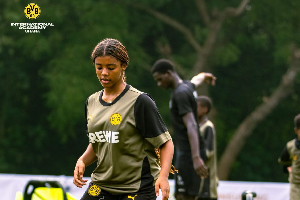Benjamin Nartey sits in one of the plastic chairs at the restaurant of Joees Plaza in Assin Fosu in the Central Region of Ghana. His black long sleeves shirt and trousers are soiled with vehicle engine oil and his body smells of the same.
“I am now learning a mechanic job,” he says with a bit of coyness from the journalists who had pointed their recording gadgets at him. “I was not learning any job it was just this year that I got enrolled in skills training by International Cocoa Initiative (ICI),” he adds.
Benjamin is only 17 years old but has over eight years experience in cocoa farming. As early as age eight, he began going to the cocoa farm with his father.
“I followed my father to the farm to collect cocoa pods to help them. I did this while I was in school but sometimes I skipped school to help my father in his cocoa farm,” he asserts.
Benjamin and his friends who worked on his father's cocoa farm got in exchange for their labour, food and they were never paid. “We ate some of the food they prepared from the farm was our pay when we work on the farm with them,” he states.
He says he engaged in this activity for several years not knowing the impact on his education although he often fell sick and had to be home most of the time.
For him, all was well till a few months ago when he was faced with the reality of having to quit school due to lack of funds to support his education.
“I could not complete my BECE examination because when it was time for me to pay my registration fees there was no one to help me,” Benjamin recalls, adding that his father whom he relied on for support had travelled during that period, “so sometimes I had to borrow money or work before I am able to go to school.”
He says he eventually had to stop school and go into full-time work as a labourer to survive at age 17. “When someone needs a labourer to weed their cocoa farm, I do it for them and I get some money,” he indicates.
Cocoa Ghana is an agricultural nation with more than half of its population engaged in different agricultural production. In Ghana, several cash crops are grown, including oil palm, rubber, and our own heritage crop cocoa.
Cocoa is the most important agricultural commodity Ghana produces and the mainstay of the country's economy.
According to data from the Ghana COCOBOD, the cocoa industry in Ghana employs approximately 800,000 farm families spread over six of the 10 regions of Ghana, generating about $2 billion in foreign exchange annually.
It further indicates that cocoa is Ghana’s second leading foreign exchange earner, worth about 30% of all revenue from export and responsible for about 57% of overall agricultural export.
As a traditional crop, cocoa has played a crucial role in generating foreign exchange earnings, government revenues, and household incomes.
Revenue from the cocoa sector has gone into the construction and maintenance of road infrastructure through the Cocoa Roads Improvement Projects, as well as in helping to curb the phenomenon of child labour in the industry.
Over the years, multinational cocoa organisations have also been working to address the issue of child labour in cocoa farms, especially the worst forms.
COCOBOD, for instance, invests an estimated amount of GH¢ 2,000,000 annually in cocoa scholarship for relatives of cocoa farmers, with about 2,500 beneficiaries accessing the scheme annually.
The scholarship is to ensure that children on cocoa farmers are not deprived education due to their parents' inability to further their education.
But despite these interventions, many children still fall through the safety net that is to, first of all, protect them from child labour and its worst forms, as well as ensure their total development in a safe environment.
Child Labour Statistics
Worldwide, reports say 101 million children are engaged in child labour in agriculture alone, with 35 million in Africa and 2.1 million being in Ghana and Ivory Coast alone.
Results of a survey research on child labour in West African cocoa growing areas by the Tulane University also shows that between 2013 and 2014, 2.26 million children were working in cocoa production, 2.12 million children were working in child labour in cocoa production and 2.03 million children were working in hazardous work in cocoa production in Côte d'Ivoire and Ghana combined.
In the aggregate, the numbers of children working in cocoa production in child labour in cocoa production, and in hazardous work in cocoa production increased by about 440,000, 360,000, and 310,000 respectively.
The percentages of children in agricultural households in each of these categories also rose between the two survey years: 19 percent for children working in cocoa, 16 percent for child labourers in cocoa, and 13 percent for children in hazardous work in cocoa, the Tulane report states.
According to the latest edition of the Ghana Living Standards Survey, 1.9 million children in Ghana are engaged in child labour; with 1.2 million in hazardous labour.
Interventions
As part of its strategies to eliminate child labour in the cocoa industry, the ICI has since 2015 been assisting the farmers to form community child protection committees, income generating groups and community service groups to develop home-grown solutions to ensure that their children developed into healthy, well-educated productive adults.
The international NGO also provides farming inputs, social amenities and other pro-poor solutions to the most vulnerable communities, which is already paying off.
Benjamin is a beneficiary of the initiative that is helping to put children into a livelihood development programme.
“I think the skills training will help me in future. I started learning the job this year and I know that very soon I can start having my own money. He hopes he will be serious with the skills training so as to help his younger brothers through school,” Benjamin narrates.
Representatives of cocoa farmers in the Assin Fosu mention the awareness and educational programmes in their communities had resulted in keeping children in the classrooms during farming hours, thus, pushing school enrolment levels high.
Okyere Bugyei, the spokesperson for Akrofuom, says they have been using their child labour toolkits to educate parents on the need to prevent their children from engaging in hazardous activities, including the inhalation of smoke and agro-chemicals.
They had also been going to the schools to monitor attendance and to educate the children on the need to complement the protection of their rights by honouring their responsibilities to study hard and be disciplined.
“ICI has empowered us to improve our standard of living; we now know how to keep proper account of our incomes, our children are given educational materials, we receive farming inputs, and our wives are now engaged in income generating activities,” Mr Bugyei says.
“The evidence is out there on the streets, we are all happy, and our marriages are thriving,” he adds.
For his part, James Kwofie, the spokesperson for Abease, another community, says the community received the Best Community Farm Award at last year's Regional Farmers' Day, while their women won the Regional Award for Best Female Rice Farmers.
This academic year, ICI provided 87 children in the Assin hub with school uniforms, footwear, and educational materials and enrolled many in schools.
The farmers applauded this support, but appealed for more to cover more children.
Improvement
The Tulane Report indicates that the number of children in hazardous work in cocoa production in Ghana decreased by 6% (from 0.93 million to 0.88 million) between 2008/09 and2013/14 with 96% attending school in 2013/14 compared with 91% in 2008/09.
Results in both countries were impacted by strong growth in cocoa production (production increases of more than 40% in Ivory Coast and more than 30% in Ghana between the years of data collection). Some hazardous activities performed by children in cocoa agriculture have also decreased.
“There was a large decrease in the percentage of children working in cocoa production participating in the hazardous activity of land clearing (-29%) in both countries combined, while there was a major increase in the percentage participating in the hazardous activity of exposure to agro-chemicals (+44%).
Overall, children working in cocoa were less likely to be exposed to multiple types of hazardous work in 2013/14. Access to education has improved with more children working in cocoa production attending school in both countries. In Ivory Coast, 71% of children working in cocoa production attended school in 2013/14, compared with just 59% in 2008/09,” the research says.
Way Forward
The Deputy Coordinator of ICI, Prince Gyamfi, points out that with the various misconceptions on child labour and what it entails, it has become very critical to ensure adequate use of the media to educate, create awareness, sensitize and engage key stakeholders and the general public on child labour and child protection issues.
“The fact that Ghana has ratified various international conventions and enacted laws on the rights of children does not translate to the enjoyment of these laws in Ghana.
There are thousands of children whose rights are being violated as these are our future leaders. We don't have to continue to just make laws, we must ensure they work,” he says.
Opinions of Sunday, 29 October 2017
Columnist: Jamila Akweley Okertchiri















